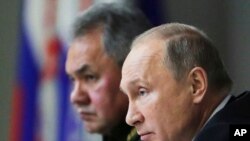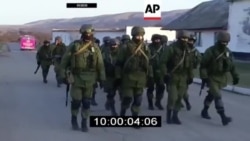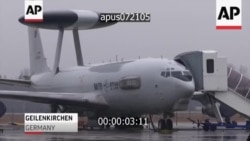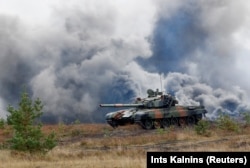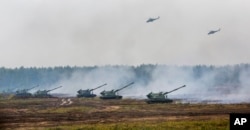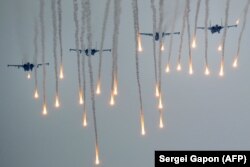Russian Defense Minister Sergey Shoigu made the statement at the annual meeting of the Defense Ministry board on December 22. He also pointed to NATO exercises featuring scenarios of a military confrontation with Russia, saying: “We carefully watch every NATO exercise and take steps accordingly.”
The remarks follow statements by Colonel General Leonid Ivashov, a former top Russian Defense Ministry official, who claimed in November that NATO and the United States were preparing to start a war with Russia. Polygraph.info fact-checked and debunked his claims.
Contrary to the statements by Shoigu and Ivashov, NATO’s presence in the region appears insignificant compared to Russia’s substantial military buildup on its western flank.
Moreover, the NATO deployments, announced in 2016, are rotational and defensive. They were initiated as a deterrence tool in response to Russia’s military actions in Ukraine and Georgia, and only serve as “tripwires” in case of a Russian attack, which would require significant reinforcements.
The deployments are specifically designed to fill gaps in the deterrence posture of the alliance, beset as it is by low military spending and the weaker military capabilities of its eastern members.
Describing the conventional threat from Russia as “real,” Brian Hook, a senior U.S. foreign policy adviser, said on November 17 at a forum by the Center for Strategic and International Studies in Washington, DC that the “military arrangement of forces in Europe favors Russia.”
In his testimony before a U.S. Senate committee in 2016, U.S. Army Chief of Staff General Mark Milley underscored that the U.S. military is “technically outranged, outgunned” by Russia’s military in Europe.
As for manpower, only 64,440 U.S. troops were deployed in Europe at the end of 2016, a significant reduction from the 285,000 deployed at the end of the Cold War. Meanwhile, the number of NATO troops in the four multinational groups deployed in Poland, Lithuania, Latvia, and Estonia stands at just 4,760 personnel. The overall number of NATO troops there is 7,200.
Commenting on the deployments, Steven Pifer, an arms control expert at the Brookings Institution in Washington, DC, underlined that the battalions “are not going to invade Russia.” They “provide tripwires” and would require reinforcements to repel a Russian attack, let alone prevail in a major conflict, he explained.
According to Richard Sokolsky, who was a member of the U.S. Secretary of State’s Policy Planning Office from 2005 to 2015, this “thin tripwire force” could prove sufficient in deterring Russia, as a similar force did in West Berlin during the Cold War. “From NATO’s perspective, this is a prudent approach that serves to bolster deterrence and reassure the Baltic states without presenting a significant military menace right up against Russia’s borders,” he wrote.
Some of Russia’s own experts dismiss or downplay Moscow’s military threat assessments.
Sergey Samuilov with the Russian Academy of Sciences’ Institute of the USA and Canada says Russia should treat the deployments calmly: “Today their number [U.S. forces in Europe] is about 60 thousand. With such a potential, the Americans and NATO will not attack Russia.”
Prokhor Tebin, an international security expert, argues that NATO’s presence in eastern Europe does not threaten Russia directly. However, he cautions that this development represents “an alarming and vexing factor” if one considers the deployment of U.S. missile defense systems in Europe and disagreements over the INF Treaty. (Polygraph.info previously examined mutual Russian and U.S. allegations of violations of the treaty in fact-check 1 and fact-check 2.)
Nevertheless, Russia’s actions in Ukraine have strained Russia-NATO ties. In 2016, Russia planned to form three new divisions in response to NATO deployments. A year later, it announced plans to create 20 new units along its western borders by the end of 2017. Russian tanks currently outnumber both U.S. and NATO ones in Europe. And, as of early 2017, Russia had 22 maneuver battalions in the Western Military District and three in Kaliningrad.
Sokolsky says NATO can ready 17 battalions for an “initial forward defense,” besides its four deployed battalions. While these capabilities are not insignificant, he notes that Russia enjoys numerical and qualitative advantages in a number of areas, including heavy armor, artillery, surface-to-surface missiles, combat aircraft and assault helicopters.
According to Sokolsky, the current dynamics in Eastern Europe present a classic security dilemma, whereby one side’s defensive moves are seen as threatening by the other. Therefore, he points out, NATO emphasizes a dual-track approach of deterrence and dialogue with Moscow.




